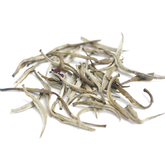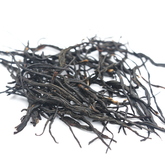A Complete Guide to Keemun Black Tea: Origins, Taste, Brewing Tips, and Health Benefits
When judges at the 1915 Panama-Pacific Exposition took a sip of Keemun tea, they wrote in their review: “Like roses, like honey, like ripe apples—this is the perfume of the East to the world.”
Keemun Tea , also known as Keemun black tea, is one of the most well-known types of Chinese black tea . Along with Darjeeling and Ceylon Uva, it is regarded as one of the "three great aromatic black teas of the world." Since its creation in the late 19th century, Keemun tea has been widely exported and enjoyed by European royalty and aristocracy. It is also the only Chinese tea to receive the prestigious title of "Queen's Tea" by the British royal family.

As a professional in the Chinese tea industry with years of experience in sourcing, this article provides a comprehensive analysis of Keemun tea, from its origin, production process, and flavor profile, to brewing methods and purchasing tips.
Where Is Keemun Tea From?
Keemun tea is produced in Qimen County , located in the southern part of Anhui Province, near the famous Huangshan Mountain. The core production areas are found in the mountainous regions of Qimen County, where the unique red clay soil (Wu Sha soil) provides an ideal environment for tea tree growth.

These natural resources, combined with the local climate, give Keemun tea its distinctive "Keemun aroma," which has earned it a place as one of the world's top three aromatic teas. In addition to Qimen County, other regions also produce black tea, but the tea from the nearby villages of Qimen stands out as the representative of the highest quality Keemun tea.
The History of Keemun Tea
Compared to other ancient Chinese teas, the history of Keemun tea is relatively short, dating back to the late 19th century. Before 1875, Qimen County primarily produced green tea.
However, during that time, a government official named Yu Gancheng (from Chizhou, Anhui) recognized the vast potential of black tea in the international market. He decided to introduce black tea-making techniques to Qimen. Drawing inspiration from the production methods of Lapsang Souchong in Fujian , Yu adapted them to the local tea tree varieties and geographical features, experimenting and innovating.
After repeated trials, Yu Gancheng and the local tea farmers successfully created a type of tea that was distinct for its floral, fruity, and honey-like aroma—this became Keemun tea. By the late 19th and early 20th centuries, Keemun teaquickly made its way to international markets, exported through Shanghai to Britain, the United States, Germany, France, and other European countries.
It became especially popular among upper-class consumers. In 1915, at the Panama-Pacific Exposition, Keemun tea won a gold medal, solidifying its place in the global tea scene.
How Is Keemun Tea Made?
Keemun tea is a type of "gongfu black tea", which emphasizes fine craftsmanship (although some processes are now mechanized). The core of its production lies in the fermentation process (oxidation), which brings out its signature aroma. The main steps involved are as follows:
Plucking: Fresh tender leaves are hand-picked during optimal weather conditions.
Withering: The harvested leaves are spread out to naturally lose moisture and soften under controlled temperature and humidity, preparing them for the next stages.
Rolling: The leaves are mechanically or manually rolled to break the cell walls, releasing tea juices that coat the surface of the leaves.
Fermentation (the core step): The rolled leaves are placed in a specific environment to undergo oxidation, developing the unique flavor of Keemun tea.
Drying: The leaves are quickly dried using high-temperature drying machines to halt the fermentation process and preserve the tea's aroma, flavor, and color.
Refining: Through screening, wind-sorting, hand-picking, blending, and re-firing, the dried tea is carefully sorted to remove impurities and stems. The final tea is blended to ensure uniform flavor, and the aroma is enhanced through re-firing to stabilize the quality.
What Does Keemun Tea Taste Like?
Keemun tea is known for its unique and irreplaceable aroma, referred to as "Keemun aroma" by Western tea connoisseurs. When you brew it, you'll first notice a delicate floral-fruity fragrance—a mix of dry rose petals, ripe plums, with a hint of warm caramel.

The taste is smooth, almost like silk, with minimal bitterness. The tea has a soft malty sweetness, mixed with mild fruity notes, such as dried plums or apricots. The aftertaste is clean and lingering, allowing the unique floral and fruity aroma to linger on your palate.
It pairs perfectly with breakfast or afternoon tea snacks: adding milk brings out soft chocolate and nutty flavors, while a slice of lemon enhances its fresh, fruity qualities. Pairing it with dark chocolate or fruit tarts provides an exquisite treat for your taste buds.
How to Brew Keemun Tea?
Easy Brewing Method
Water Temperature: Around 90°C, avoiding boiling water to prevent bitterness.
Tea-to-Water Ratio: 3-5g of tea per 300ml of water, adjustable to your preference.
Brewing Time: 2-3 minutes.

Traditional Gongfu Brewing
Tea-to-Water Ratio: 5g of tea per 120ml Gaiwan .
Water Temperature: 90°C, avoiding boiling water.
Brewing Method: Pour out the tea after 5-10 seconds, avoiding steeping for too long. The steeping time can be gradually increased after the first infusion.

Note: It is recommended to use filtered or bottled water, as chlorine in tap water can ruin the flavor, and the tea will become bitter. Also, avoid steeping the tea too long, as prolonged immersion leads to bitterness.(Further reading: A Beginner's Guide to Perfect Tea Brewing
If the tea is too strong, try reducing the amount of tea or shortening the steeping time (while keeping the water temperature constant). If it's too weak, increase the tea amount.
How to Store Keemun Tea?
To maintain the charming "Keemun aroma" and freshness of Keemun tea, the key is to isolate it from air, moisture, light, heat, and odors. Here are some tips for storing Keemun tea.(Further reading: Does Tea Expire? How to Properly Store Your Tea
Use a sealed container to block oxygen
Tea absorbs moisture and odors, so it should be stored in a well-sealed container, such as a stainless steel tin, aluminum can, or ceramic jar. After opening the packaging, transfer the tea to an opaque container with a sealing ring or a high-quality resealable food bag.
Store in a cool, dry place
Always store tea away from humid environments. The kitchen sink, dishwasher, or refrigerator are not ideal storage spaces.
Avoid absorbing odors
Tea readily absorbs odors from its surroundings. Therefore, it must be kept away from strong odor sources like spices (coffee beans, cinnamon, chili), onions, garlic, cleaning products, or scented candles.
Health Benefits of Keemun Tea
As a fully fermented black tea, Keemun tea's health benefits primarily come from its rich bioactive compounds.
However, it's important to note that Keemun tea should be considered a beneficial supplement to a healthy lifestyle, not a standalone treatment. Also, avoid drinking Keemun tea on an empty stomach, as it may cause digestive discomfort.
A Friend to Your Heart
Core Component: Keemun tea is rich in theaflavins (natural antioxidants), which are present in higher amounts than in regular black tea.
Scientific Evidence: Drinking 3 cups of Keemun tea daily for 8 weeks has been shown to reduce LDL cholesterolby 11.3%, which helps reduce the risk of arterial blockages (clinical trial by Anhui Agricultural University).
Blood Sugar Stabilizer
After meals, Keemun tea's special components, including tea polysaccharides and catechins, have been shown to:Slow the absorption of sugars from food.
Keep post-meal blood sugar levels more stable.
Scientific Evidence: Drinking 300ml of Keemun tea after meals can make the blood sugar rise more gradually, reducing peaks by 25% (report by the German Nutrition Institute).
Natural Stress Reliever
The unique "rose aroma" of Keemun tea comes from a natural compound called linalool. Research shows that L-theanine (10-20mg per cup) helps the brain release alpha waves, creating a relaxed but alert state and reducing tension (verified by the Journal of Nutritional Neuroscience).
How to Buy Quality Keemun Tea?
Avoid Broken Tea and Flavored Tea
Broken tea is typically marked as "Broken Grade" or "BOP". It’s prone to bitterness and lacks the signature Keemun aroma. Also, avoid flavored teas labeled with "Natural Flavor" or "Rose Extract," as these can mask the underlying poor-quality tea base.

Choose Small Sample Packages
For first-time buyers, it's recommended to buy small sample packages to assess the flavor and quality before purchasing a larger quantity. This helps avoid buying tea that doesn't suit your taste.
Check the Expiry Date
Keemun tea has a shelf life, so always check the production and expiry dates. Fresh Keemun tea offers the best aroma and flavor.
Conclusion
As the only Chinese representative among the world’s three great aromatic teas, Keemun tea holds a world-class certified flavor profile with both EU PGI and China GI certifications. Its distinct aroma, sourced from the natural environment of Qimen County, combined with excellent craftsmanship, makes it a tea worth savoring.
Scientific studies also show that moderate consumption of Keemun tea supports heart health, helps manage blood sugar, and provides a natural way to relieve stress. When purchasing Keemun tea, always look for products with geographical certification and avoid lower-quality broken or flavored teas to ensure the best flavor and quality.
FAQs about Keemun Tea
Q1:What’s the difference between Keemun tea and English Breakfast tea?
Keemun tea is whole-leaf loose tea with a smooth, layered flavor, while English Breakfast tea is typically made from broken leaves and has a stronger, single-note taste.
Q2:Does Keemun tea contain caffeine?
Yes, it contains moderate amounts of caffeine, suitable for most adults. Those sensitive to caffeine should consume it in moderation.
Q3:Is Keemun tea good for breakfast?
Yes, its mild flavor makes it an excellent choice for morning refreshment.
Q4:How should I store Keemun tea?
Store it in a sealed container, away from sunlight and humidity, to maintain freshness.
Q5:Can Keemun tea be consumed in the evening?
It can be, but avoid drinking it right before bed or after brushing your teeth to prevent sleep disturbances.
Q6:Is Keemun tea suitable for cold brewing?
Yes, cold brewing Keemun tea will bring out a sweeter taste with less bitterness.
Q7:Does Keemun tea have a shelf life?
Yes, it has a best-before period, generally within 1 year of production for the freshest flavor.
Q8:Can Keemun tea be paired with milk?
While it can be, its natural floral and fruity notes are best enjoyed on their own without milk.
SEE MORE
If you are a beginner about Chinese tea:
Basic-Guide-to-Chinese-Tea
If you have questions about selecting tea:
Learn-more-about-chinese-tea
If you have questions about the benefits of tea:
Health-benefits-of-chinese-tea
If you have questions about brewing tea:
How-to-brew-loose-leaf-tea






